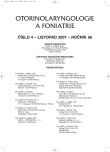Prognostic Factors of Chronic Otitis. Part 2 - Method of Surgical Treatment
Authors:
Viktor Chrobok 1
; A. Pellant 1,2; M. Meloun 3; K. Pokorný 1; E. Šimáková 4
Authors‘ workplace:
Klinika otorinolaryngologie a chirurgie hlavy a krku, Pardubická krajská nemocnice, a. s.
1; Fakulta zdravotnických studií, Univerzita Pardubice
přednosta prof. MUDr. A. Pellant, DrSc.
Katedra analytické chemie, Fakulta chemickotechnologická, Univerzita Pardubice
2; přednosta prof. Ing. K. Vytřas, DrSc.
Fingerlandův ústav patologie, LF UK a FN, Hradec Králové
3; přednosta prof. MUDr. A. Ryška, Ph. D.
4
Published in:
Otorinolaryngol Foniatr, 56, 2007, No. 4, pp. 208-219.
Category:
Original Article
Overview
The state of hearing before and after the operation was evaluated in a retrospective study of patients surgically treated for chronic otitis according to individual per operation characteristics - the type of surgery, type of tympanoplasty, reconstruction of the posterior wall of external auditory came, the type of auditory came plasty, meatoplasty, resection of the mastoid process and obliteration of trepanation cavity.
The hearing improved after myringoplasty in all freguencies by 3 to 8 dB on the average and after myringostapedopexy on the frequencies 1 and 2 kHz by 2 dB. In the application of PORP the hearing threshold improved by 5 dB on the frequency of 500 Hz, other frequencies descreased by 1 to 18 dB. In the group with TORP the aerial conduction improved on the frequencies of 500 Hz by 6 dB and 1 kHz by 2 dB, other frequencies of 0.5 1 a 2 kHz remained without changes of air conduction, high frequencies of 3 and 4 kHz deteriorated by 6 and 5 dB.
A more extensive intervention on the temporal bone and middle car ossicles was associated with a deeper hardness of hearing before as well as after the surgery. The reconstruction of the external auditory came posterior wall, external auditory came plasty, resection of the mastoid process or obliteration of trepanation cavity may not be considered as primary negative factors of the state of hearing, since execution of these kinds of interventions depends on the extent, type and localization of chronic otitis.
Key words:
chronic otitis, hearing threshold, mastoidectomy, tympanoplasty, meatoplasty, obliteration of trepanation cavity, statistics, prognostic factors.
Sources
Citace literárních prací budou uvedeny v článku Prognostické faktory chronického středoušního zánětu - 3. část, která bude v našem časopisu publikována v čísle 1/2008.
Labels
Audiology Paediatric ENT ENT (Otorhinolaryngology)Article was published in
Otorhinolaryngology and Phoniatrics

2007 Issue 4
Most read in this issue
- Beta-hemolytic Streptococci of Serological Group C and Acute Tonsillopharyngitis. Epidemiologic Study
- Pain in the Head and Neck Region - Arthritis of the Temporomandibular Joint
- Chronic Rhinosinusitis with Nasal Polypi and Staphylococcus aureus
- Amyloidosis of Upper Respiratory and Swallowing Pathways
